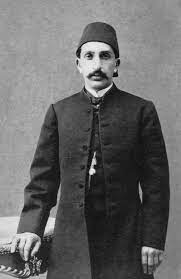sultan Abdülhamid
Abdülhamid or Abdul Hamid II Ottoman Turkish عبد الحميد ثانی romanized: Abd ül Hamid i Sani Turkish II Abdülhamid 21 September 1842 10 February 1918) was the sultan of the Ottoman Empire from 31 August 1876 to 27 April 1909 and the last sultan to exert effective control over the fracturing state. The time period which he reigned in the Ottoman Empire is known as the Hamidian Era. He oversaw a period of decline, with rebellions particularly in the Balkans and he presided over an unsuccessful war with the Russian Empire 1877 1878 followed by a successful war against the Kingdom of Greece in 1897 though Ottoman gains were tempered by subsequent Western European intervention.In accordance with an agreement made with the Republican Young Ottomans, he promulgated the Ottoman Empire's first Constitution which was a sign of progressive thinking that marked his early rule. However in 1878, citing disagreements with the Ottoman Parliament. He suspended both the short lived constitution and the parliament. The modernization of the Ottoman Empire continued during his reign including reform of the bureaucracy the extension of the Rumelia Railway and of the Anatolia Railway and the construction of the Baghdad Railway and of the Hejaz Railway. In addition systems for population registration and control over the press were established along with the first local modern law school in 1898. The most far reaching of the reforms occurred in education: many professional schools were established for fields including the law arts trades civil engineering veterinary medicine customs farming and linguistics. Although Abdul Hamid II closed Istanbul University in 1881 it re-opened in 1900, and a network of secondary primary and military schools was extended throughout the empire. German firms played a major role in developing the Empire's railway and telegraph
systems. This modernization cost the empire its economic sovereignty, as its finances came under control of the Great Powers through the Ottoman Public Debt Administration.During Abdul Hamid's reign the Ottoman Empire became known for the massacres of Armenians and Assyrians of 1894 1896. Many attempts were made on Abdul Hamid's life during his reign. Amongst the many assassination attempts against him one of the most famous is the Yıldız assassination attempt of 1905 by the Armenian Revolutionary Federation. Large sections of the Ottoman intelligentsia also sharply criticized and opposed him due to his use of secret police to silence dissent and the Young Turks movement. In 1908, a secret revolutionary Young Turks organization known as the Committee of Union and Progress forced Abdul Hamid II to recall the parliament and reinstate the constitution in the Young Turk Revolution. Abdul Hamid attempted to reassert his absolutism a year later, resulting in his deposition by Unionist forces in an event known as the 31 March Incident in 1909.







0 Comments